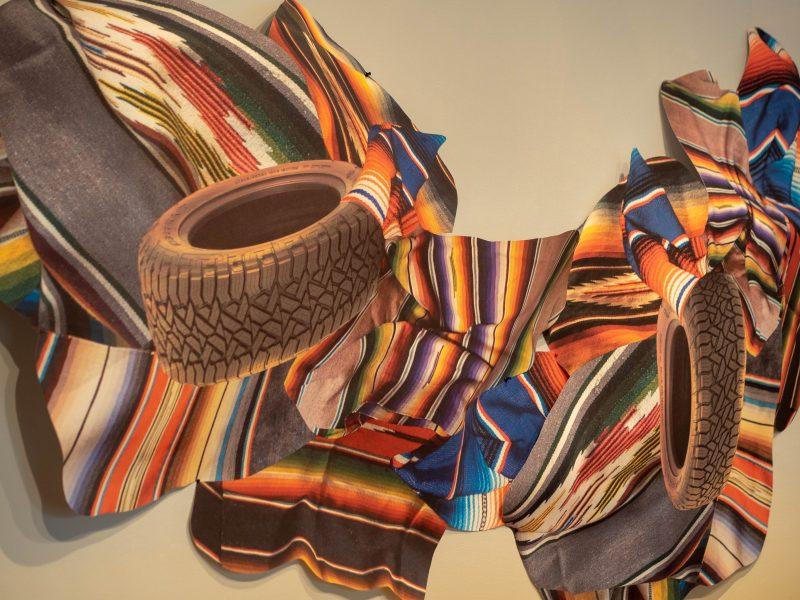Trinity Art Department and Blue Star Contemporary opened an exhibition of new works by Dallas artist Sara Cardona titled “This Is Only a Test.” In this exhibit, Cardona explores her Mexican heritage through paper collage.
The most striking aspect of this exhibit is the prevalence of traditional Mexican textile patterns, from multicolor rows of woven cloth to tangled blankets and bandanas. Each piece presents this tradition in different ways, whether through presenting the patterns themselves or superimposing images of public transit routes or popsicles. The textiles are cut up and placed in strips as part of a modern interpretation of these traditional patterns.
The familiar and traditional materials show how the exhibit approaches nostalgia; Cardona’s art invokes communication modes such as color bar tests and Polaroid photos, which have been obsoleted by technological advancements, yet retain ubiquity in television, photography and pop culture.
In a similar way, the subjects of “This Is Only a Test” raise numerous questions about communication, tradition and the expression of meaning. For instance, Cardona refers to how jergas are woven textiles, but the word “jerga” translates from Spanish to slang and jargon, suggesting a distance between the physical and nonphysical meanings.
Cardona addressed major themes in her work during the opening reception.
“The main motif in these works is probably transit; like a back-and-forth between Mexico and the U.S., of culture and consumerism,” Cardona said. ”In this sense, blankets have multiple meanings: for one thing, they are symbols of Mexican culture still in use by Mexican people, but on another hand, [getting into the transmission of culture], there are pickup truck carseats with these blankets draped over them. … I use pop cultural references to portray how we consume culture.”
Cardona explained how the pieces were not just about communication, but about miscommunication. The glitches on TV screens in Cardona’s artworks signify transcultural communications. In addition, Cardona’s pieces’ Spanish titles contain slang terms and jokes; cultural nuance that is often lost in the English titles.
“There’s a lot of old-fashioned editing and splicing techniques being invoked to convey the sense of having things lost in translation, edited and recontextualized,” Cardona said.
Cardona’s approach to collage is deliberate, with folded sets of blankets and textiles splayed out wildly from fixed points. These pieces are purposefully round to express circularity and timelessness.
One of Cardona’s pieces, “Gira la Botella/Spin The Bottle,” invokes a childlike expression karma to express an ongoing relationship with the consequences of consumer culture, a theme expressed in many pieces. Cardona said that the familiarity of nostalgic objects indicates immortality as well as the effacement of their cultural nuances and significance.
The piece greeting the audience, “Lo Que El Viento Se Llevó/Gone With The Wind,” is an ephemeral piece where 3D parts “float away,” suggesting fundamental instability. The intersection of tires and textiles represents remnants of a community that Cardona herself knew.
“[This piece] signifies travel and movement, especially given the neighborhood it was based on,” Cardona said. “This neighborhood had a lot of mechanics and auto shops, and this was necessary because it was a space where a lot of travel occurred. But eventually, as people moved and as these auto shops get closed, all of a sudden it’s gone.”
Mark Martinez, gallery manager for the Neidorff art gallery, also discussed this piece, which bulges irregularly from its wall. Martinez explained how the piece’s ephemerality, due to its heaviness and the work it took to mold into shape the loose idea that Cardona had for it, indicates a transience and poignancy to the exhibit.
Cristina Treviño, junior, appreciated the piece’s innovative aspects.
“3D collage work is bold to begin with, and achieving the optical illusion of being flat from a distance shows a lot of technical skill,” Treviño wrote in an email interview. “It was a great opener, and I’m interested to see more of Cardona’s sculpture installations.”
Treviño was impressed by what she felt was Cardona’s unique take on Mexican culture.
“The imagery and color scheme of serapes are very common in the artwork of Mexican and Chicanx people who are based in the United States,” Treviño wrote. “Going into the exhibit, I was apprehensive that it would blend into a sea of other artists that use the same imagery. I was pleasantly surprised that Cardona’s work stood out regardless.”
Cardona presents a wide range of interacting themes and emphasizes the importance of humor in dealing with tension, but also invites viewers to form their own interpretations based on their experiences. “This Is Only a Test” will run until Nov. 9.







